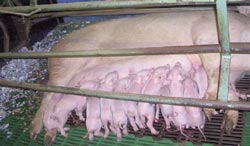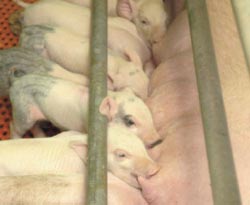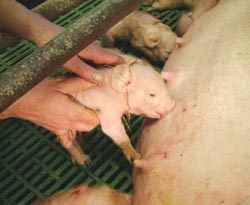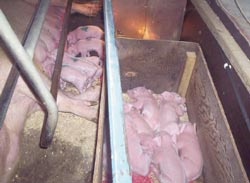



Colostrum: Food for Life
An article from BPEX in the series Action for Productivity. Its targets are to optimise colostrum production by the sow; to make sure that piglets suckle within 6 hours of birth; and to ensure that every piglet gets a fair share of the colostrum (minimum 100ml in the first 16 hours).Colostrum is secreted from the udder immediately after farrowing and within several hours, its composition changes rapidly to that representing sow milk. Colostrum contains essential antibodies (immunoglobulins) for the health of the newborn piglet; antibodies are produced by the body to kill bacteria and viruses. The piglet is born with very few of the protecting antibodies necessary to thrive and relies strictly on the sow’s colostrum to obtain them in the defence against bacteria and viruses.
Colostrum is a rich source of highly digestible nutrients, which are critical to establishing the newly born piglet and studies indicate that colostrum contains natural growth factors for the normal development of vital life-sustaining organs, e.g. brain, heart, pancreas, liver and kidneys, and the immature gut.
Colostrum Intake by the Newborn Piglet

- Colostrum intake by the newborn piglet is highly variable and may range from 200 to 450g per piglet.
- Intake depends not only on the piglet's ability to extract colostrum but also on the ability of the sow to produce enough for the whole litter.
- Many factors can influence both colostrum production and consumption, eg sow parity and nutrition, litter size and piglet vigour at birth.
- Piglets with very low birth weights and which lack vigour at birth may not consume sufficient colostrum for survival or for their longer-term health and performance.
What Happens if Piglets Consume Little or no Colostrum?

- The amount and timing of colostrum consumption are both critical to the subsequent health, development, survival and lifetime performance of the newborn piglet.
- Colostrum intake must be optimised as soon as possible after farrowing.
- After 6 hours the gut begins to 'close' and after 24 hours, the full benefits of the immunoglobulins are no longer available to the piglet.
- During this critical window, the piglet is able to rapidly absorb the protective colostral factors (immunoglobulins), which are essential for good health and performance.
- Unless sufficient colostrum has been consumed, the piglet remains highly vulnerable to disease.
- The minimum threshold requirement for colostrum is unknown; however a general guide is that piglets will consume 150-280g/kg bodyweight soon after birth.
MANAGEMENT GUIDELINES
How Can Colostrum Production be Optimised?

Little is known about the factors affecting colostrum production but the rearing strategy for replacement gilts, vaccination policy and the disease and hygiene status of the farm are likely to influence the immunological properties of colostrum.
Apply best sow management principles to ensure high colostrum and milk yields and sow litter productivity:
- Reduce stress before, during and after farrowing.
- Feed diets appropriate for pregnancy and lactation (see the Stotfold sow feeding strategy).
- Ensure sows have unrestricted access to fresh drinking water at all times.
How Can Each Piglet Get a Fair Share of the Colostrum?

Split suckling
- Supervise farrowing
Supervision during and immediately after farrowing should focus on early establishment of piglets at the teats to ensure adequate intake of colostrum; remember the ability to absorb antibodies falls rapidly after 6 hours and is almost completely gone 24 hours after birth. - Batch farrowing
This can assist in the planning and implementation of stockworker supervision of sows and piglets at farrowing. - Synchronised farrowing
The use of synchronising agents needs careful consideration and should be discussed with your veterinarian. - Cross fostering
To ensure colostrum sharing, cross fostering should take place as soon as possible following birth, ideally across sows within 24 hours or sooner after farrowing. If this is not possible, colostrum sharing in large litters should be facilitated by shift (split) suckling. - If porcine colostrum is unavailable, bovine colostrum may be used as a substitute.
- Consider milking off surplus colostrum from some sows, freezing and using for compromised pigs. (Do not defrost using a microwave!) However on most commercial farms, milking sows is not a practical option.
September 2008








